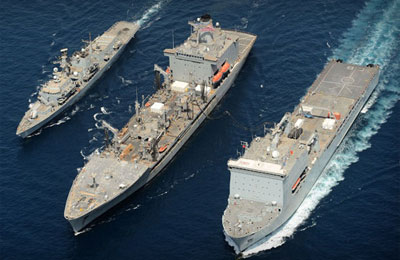
Gulf naval drill highlights mine risk to shipping
Manama, May 19, 2013
A major international naval drill being conducted in the Gulf has highlighted real concerns about the potential risk to global shipping from mines planted at sea, a report said.
Military chiefs have been quick to play down suggestions that the exercise, which includes navies of more than 41 countries, is being conducted with one eye on Iran, reported the Gulf Daily News (GDN), our sister publication.
However, Tehran has repeatedly threatened to close the Strait of Hormuz - through which around 35 per cent of the world's oil shipments at sea pass - due to ongoing tensions over its nuclear programme.
Tension
Sources told the GDN that Iran is believed to have a stockpile of more than 5,000 mines at its disposal, which suggests claims that Iran is not on the radar during the ongoing naval exercise are simply an attempt to avoid stoking tensions even further.
The International Mine Counter Measure Exercise 2013 started on May 6 and will continue until May 30.
It is being conducted in the international waters of the Gulf and is being closely monitored by Iran, which has its own naval vessels patrolling the area and has warned against any provocations.
The GDN was among more than 25 media organisations from around the world to spend two days at sea onboard the UK's HMS Shoreham and America's USS Ponce, which are taking part in the exercise.
Navy personnel from France, Germany and several Arab countries are taking part in the drill, which features 35 ships, about 6,000 personnel, 18 Unmanned Underwater Vehicles (UUVs) and 100 Explosive Ordinance Disposal (EOD) divers.
Rights
It is being held close to Strait of Hormuz, but commander of Task Force 52 Commodore Glenn Allen said it did not infringe on the rights of any country.
"We have every right to carry out this defence exercise in international waters," he said. "It is not done in the territorial waters of any country."
He added that mines were one of the easiest ways to disrupt shipping.
"Mines are cheap, intelligent and sophisticated as they can destroy a billion dollar ship," he explained. "Mines are like IEDs (Improvised Explosive Devices) in the ocean. A global effort is required to ensure there is free flow of commerce and to stop these weapons from reaching terrorist outfits."
Royal Australian Navy Mine Warfare and Clearance Diving Task Group commander Douglas Griffiths reiterated that the massive exercise was not only about Iran.
"This is not focused on Iran," he said. "There are other important strategic routes which, if affected, could affect the flow of global trade. For example, if oil price increases because of the blocked route, it can become a global threat."
In fact, HMS Shoreham executive officer Lieutenant Tim Castrinoyannakis said there was still a threat from mines planted at sea during the Second World War.
"The threats are always there and you have to be prepared to deal with it," he said.
"Mines are cheap and if laid in international waters, it becomes a serious issue. There are still thousands of mines still in the seas planted during Second World War which pose a threat to ships and international trade. Mines placed in the territorial waters of a country should be declared to the international community. However, free floating mines in international waters are illegal."
Warships equipped to tackle mines fall into two different categories - minesweepers and mine hunters.
The former uses wires dragging behind it to detonate or snag mines they come into contact with, while the latter uses sophisticated sonar, divers and remote-controlled SeaFox mine disposal devices that can operate as deep as 600 metres.
HMS Shoreham commanding officer Lieutanant Commander Mark Hammon said techniques used during the exercise were being shared with regional allies including Bahrain.
"Bahrain, Saudi Arabia and the UAE are learning from our experience and this helps them gain responsibility and enhance maritime security," he said.
Measures
The US and the UK have both beefed up their mine countermeasure capabilities in the region, increasing the number of specialist vessels stationed in Bahrain.
Technologies employed on vessels such as the USS Ponce include the unmanned ScanEagle drone, which can remain in the air for 24 hours - capturing real time footage of the entire area around the vessel.
"Mine countermeasures are important because there are key choke points in this region such as Bab Al Mandeb, the Suez Canal and the Strait of Hormuz, which if blocked, affects maritime trade," said USS Ponce commanding officer Captain Jon Rodgers.
Iran has just conducted its own anti-mine exercise, unveiling its first indigenously developed minesweeping system.
However, Captain Rodgers said Tehran appeared to be particularly interested in monitoring the international exercise currently underway - revealing that his vessel had come into contact with several Iranian navy ships, although there had been no incidents.
"We have interacted about 30 times with them (Iran) and it has always been in a professional manner," he said. "They sure are excited about this exercise." – TradeArabia News Service







